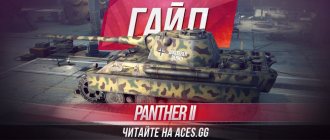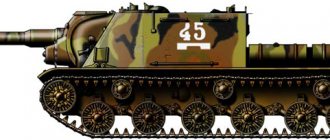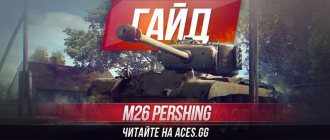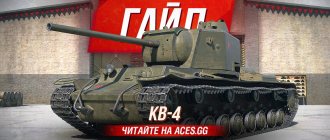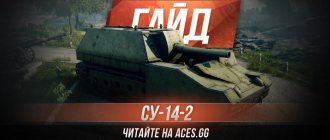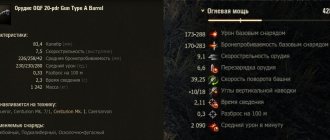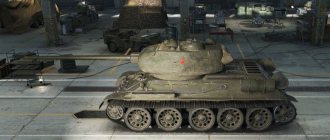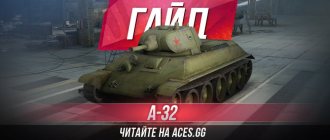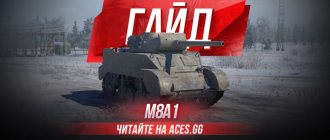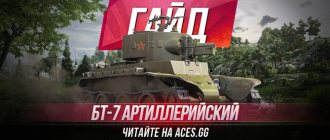Good day to all lovers of slow technology, aces.gg here! Friends, now we will talk about a car that gives an excellent idea of what awaits you as you continue through the selected branch. We are talking about an American tank destroyer of the eighth level - this is the T28 guide.
Indeed, in terms of gameplay, this unit is in many ways similar to the next tank in this development branch - the T95. But let's refrain from spoilers, look at the T28 characteristics in detail, and you yourself will understand what we are talking about.
TTX PT-SAU T28
To better understand what this unit is capable of, first of all, it is worth saying that we have at our disposal a good margin of safety by the standards of our classmates, but the basic viewing range of 370 meters is a let down, this will not be enough.
If we consider the T28 performance characteristics of the reservation, this is a very controversial point. The strongest part of our vehicle is the forehead; the wheelhouse and hull are armored really well, but only by the standards of the eighth level. As soon as your opponent charges golda, or if level 9-10 tanks shoot at you, the armor immediately turns into mediocre.
Regarding the sides, they are cardboard; the T28 tank can easily penetrate any firefly. The same applies to a thin roof and an even thinner stern; you only need to face the enemy with your forehead. By the way, there are also various hatches on the roof, it’s also very easy to get through here, you just need to get in.
The good news in terms of survivability is the fact that we have a rather squat silhouette, thanks to this good camouflage is achieved and it is not so easy to detect this unit while you are standing.
The mobility of the T28 World of Tanks tank destroyer is very poor, this is exactly the factor that prepares you for playing the T95. Our maximum speed is very low, we move backwards completely disgustingly, the dynamics are terrible. As for maneuverability, this parameter is no better; even a more or less mobile rod can easily spin us around.
Modules:
Turrets/guns
| Lv. | Tower | Armor (mm) | Rotation (deg/sec) | Review (m) | Weight, kg) | Price (credits) |
| III | T-28 cylindrical | 20/20/20 | 46 | 320 | 2 000 | 2 160 |
Compatible weapons:
| Lv. | gun | Penetration (mm) | Damage (HP) | Rapid fire (rounds/min) | Spread (m/100m) | Mixing (c) | BC | Weight, kg) | Price (credits) |
| IV | 76 mm F-32 | 67/75/38 | 110/110/156 | 15.38 | 0.51 | 2.9 | 69 | 770 | 27 610 |
| IV | 57 mm ZiS-8 | 75/112/29 | 75/75/95 | 20.69 | 0.45 | 2.3 | 78 | 400 | 22 910 |
| V | 57 mm ZiS-4 | 112/189/29 | 85/85/95 | 22.22 | 0.34 | 2.3 | 78 | 740 | 41 480 |
| II | 76 mm KT-28 | 37/75/38 | 110/110/164 | 13.04 | 0.6 | 2.3 | 69 | 540 | 3 580 |
| III | 76 mm L-10 | 66/75/38 | 110/110/164 | 13.04 | 0.57 | 2.9 | 69 | 641 | 10 310 |
| Lv. | Tower | Armor (mm) | Rotation (deg/sec) | Review (m) | Weight, kg) | Price (credits) |
| IV | T-28 conical | 25/25/25 | 44 | 340 | 2 500 | 4 370 |
Compatible weapons:
| Lv. | gun | Penetration (mm) | Damage (HP) | Rapid fire (rounds/min) | Spread (m/100m) | Mixing (c) | BC | Weight, kg) | Price (credits) |
| IV | 76 mm F-32 | 67/75/38 | 110/110/156 | 15.38 | 0.51 | 2.9 | 69 | 770 | 27 610 |
| IV | 57 mm ZiS-8 | 75/112/29 | 75/75/95 | 20.69 | 0.45 | 2.3 | 78 | 400 | 22 910 |
| V | 57 mm ZiS-4 | 112/189/29 | 85/85/95 | 22.22 | 0.34 | 2.3 | 78 | 740 | 41 480 |
| II | 76 mm KT-28 | 37/75/38 | 110/110/164 | 13.04 | 0.6 | 2.3 | 69 | 540 | 3 580 |
| III | 76 mm L-10 | 66/75/38 | 110/110/164 | 13.04 | 0.57 | 2.9 | 69 | 641 | 10 310 |
Engines
| Lv. | Engine | Power (hp) | Fire probability (%) | Weight, kg) | Price (credits) |
| IV | M-17T | 500 | 20 | 610 | 13 460 |
| IV | M-17L 1400 rpm | 450 | 20 | 610 | 10 770 |
| IV | M-5-400 | 400 | 20 | 410 | 10 230 |
Chassis
| Lv. | Chassis | Max. load (t) | Turning speed (gr/sec) | Rmin | Weight, kg) | Price (credits) |
| III | T-28 | 18.9 | 35 | B/2 | 5 160 | 2 270 |
| IV | T-28A | 32.3 | 40 | B/2 | 5 300 | 5 250 |
Radio stations
| Lv. | Radio station | Communication range (m) | Weight, kg) | Price (credits) |
| III | 71-TK-3 | 300 | 100 | 570 |
| V | 10R | 360 | 100 | 3 660 |
gun
As you can see, the general characteristics of our American leave much to be desired, but do not despair, the situation with weapons here is better.
The T28 gun is far from the largest at the alphastrike level, but we were given a good rate of fire, due to which we can deal approximately 2650 units of damage per minute, this DPM is one of the best at the level.
Regarding the armor penetration parameters of the T28 WoT, everything is also quite good, the basic shells are enough to penetrate even level ten armored vehicles into vulnerable places, but it’s worth carrying about 20-30% of gold cartridges with you if the enemy is standing too well.
If we talk about accuracy, the tank has quite good accuracy. Yes, the spread is large, but the stabilization is tolerable, and the T28 World of Tanks settles down quickly. But I want to warn you that it will not be comfortable to shoot at a distance of over 350 meters.
The last thing I want to say in terms of weapons is that we have fairly comfortable horizontal aiming angles; you can rotate the gun 10 degrees to the left and 11 to the right. But the UVN of the T28 PT-SAU was greatly let down; the gun goes down only 5 degrees and this will often not be enough.
T-28 first medium “breakthrough tank”
Part II
Almost everyone knows about the T-28 tank. But it was this particular vehicle that caused and still causes a huge number of mutually exclusive assessments of its combat characteristics. From “the best medium tank in the world” to “a technically and morally obsolete pile of scrap metal.” Let's try to formulate our own point of view on this tank.
Created within the framework of the first program for arming units of the Red Army with armored vehicles, developed by the headquarters of the Red Army at the end of 1929, the tank was intended to “... qualitatively strengthen combined arms formations when breaking through heavily fortified defensive lines...”.
The history of its creation is discussed in detail in the previous article. 08/11/33 the tank was put into service. In this material I will dwell in more detail on the main characteristics: armor and weapons.
The T-28 is a medium tank that had a three-turret layout, which at the time of its development was considered classic. The weapons on it were placed in two tiers. The engine was installed in the stern (engine and transmission compartment). In the frontal part there was a control compartment combined with the combat compartment. The crew of the tank consisted of 8 people, and in the tank itself there were only 6 tankers (Red Army Charter as amended on 01/01/36):
- Tank commander;
- Junior tank technician (modern driver mechanic);
- Driver mechanic (fires from the left machine-gun turret during battle, and between battles maintains the engine);
- The commander of the artillery tower fires from a gun. He is responsible for arming the tank;
- The commander of machine gun turret No. 3 (right) - fires a machine gun in battle, and maintains the chassis between battles;
- Radiotelegraph operator - performs the duties of a loader in battle;
- Junior driver - Located outside the tank. After the battle and in the pre-battle situation, provides maintenance of the chassis;
- Motorman - Located outside the tank. After the battle and in pre-battle conditions, provides engine maintenance.
Armament.
The tank's armament was constantly changing. The first pre-production models (T-28-1 produced in 1932) were equipped with a 45 mm tank gun in the main turret and 3 DT machine guns (one coaxial with the gun in the main turret and one each in the machine gun turrets).
The first production models of the T-28, produced in 1933-1934, were equipped with a short-barreled KT-28 gun (the abbreviation stood for “Kirov tank”) of the 1927-1932 model:
- Gun caliber - 76.2 mm;
- The barrel length was 16.5 caliber;
- The mass of a high-explosive fragmentation projectile is 7 kg;
- The initial speed of this projectile is 262 m/sec;
- The mass of the shrapnel projectile is 6.5 kg;
- The initial speed of this projectile is 381 m/sec;
- The mass of the swinging part was 540 kg;
- Declination angle max – minus 5 degrees;
- Elevation angle max – plus 25 degrees;
- The lifting mechanism is a manual sector type.
This gun coped well with unarmored targets and firing points. But it was clearly weak for combating armored targets, due to the insufficient initial velocity of the projectile, for which it was subject to repeated criticism from the military. The design team working on the T-28 project was well aware of this shortcoming and considered the installation of the Kt-28 only as a temporary measure. Instead, the main gun of the tank was supposed to be the PS-3 (tank) gun. But due to a number of objective and subjective reasons, it was never finalized and did not go into production.
In addition to the cannon, the tank was armed with four DT machine guns. Two of them were located in machine gun turrets. The third is in the ball joint to the right of the gun in the main turret. This machine gun had horizontal firing angles +/- 30 degrees, elevation/decrease angles + 30 / - 20 degrees. The fourth was a spare one and was intended for firing in the rear hemisphere.
T-28 tanks of the 1934 model (produced in 1934-38) were armed with a KT-28 cannon and DT machine guns (4-5 pieces). Four of them were installed according to the option described above. The fifth was installed in the P-40 anti-aircraft turret, which was mounted on the gunner's hatch from the end of 1936. This machine gun was equipped with a special collimator sight.
For firing backwards, first a yoke and then a ball support for the diesel engine were mounted in the niche of the main turret. Moreover, starting from 1939, on the personal order of K.E. Voroshilov, who was at that time the People's Commissar of Defense, this machine gun had to be permanently in the niche.
The T-28 model 1938 (produced from 1938 to 1940) was armed with the new L-10, a 76.2 mm tank gun that received an armor-piercing projectile that the KT-28 did not have. The length of its barrel had already reached 26 calibers, and the initial speed of this projectile was 555 m/sec. The installation of this gun significantly increased the combat capabilities of the T-28 in destroying armored targets (from a distance of 1000 m, an armor-piercing projectile penetrated 50 mm of armor at an impact angle of 60 degrees to the normal). However, the L-10 was significantly inferior to its predecessor, the KT-28, in terms of ease of use and reliability. The number of DT machine guns is five.
The TOP (telescopic sight) of the 1930 model and the PT-1 (tank periscope) of the 1932 model were used as sighting devices for firing from the cannon. In addition to these sighting devices, on the right side of the main turret, symmetrically with the periscope sight in the roof, there was a commander’s panorama. The firing sector for the main turret was 360 degrees, for the small machine-gun turrets – 165 degrees.
The T-28 ammunition of all modifications consisted of 69 unitary rounds for the cannon and 126 magazines for machine guns (7938 rounds).
Reservation.
The tank's hull was box-shaped and was manufactured using two technologies: when made from cemented armor - riveted-welded; when manufactured from homogeneous armor - fully welded. The latest tanks (1938-1940) had hulls made according to the first option. The thickness of the armor plates used ranged from 30 mm (front) to 13 mm (side, rear).
The tank's turrets, both the main one and the machine-gun turrets, were made using the same technologies from rolled sheets of armor 15 - 20 mm thick. The combat experience gained during the “Winter War” with Finland demonstrated the weakness of the T-28’s armor. This entailed the creation of a scheme for additional tank armor by installing screens (welding armor plates 20-30 mm thick onto the hull and turrets). As a result of this modification, the thickness of the frontal armor of the hull and turret increased to 50-80 mm, and the sides and stern - to 40 mm. A tank that had undergone screening received the index T-28E. The weight of the tank increased from 18 to 32 tons, which significantly worsened the dynamic characteristics of the vehicle, its cross-country ability and maneuverability. During 1940, screens were installed on 103 tanks in full and on 8 tanks partially.
Comparison with similar tanks of the world's leading powers
The main evaluation parameters for armored vehicles have always been armor protection, armament and mobility. Based on the combination of these parameters, the T-28 in the thirties of the 20th century was de facto the most advanced tank in the world. At the time of the start of its mass production (1933), mass-produced analogues simply did not exist in other countries. Example: German armored forces did not exist at all; French tank units were almost 100% equipped with light FT-17s. And only a few years later tanks appeared in England, France and Germany, comparable in characteristics to our T-28. Let's look at them in more detail.
Vickers Mk 1 (Vickers A 9) - English cruiser tank. It was developed since 1934 on the basis of the Vickers 16-ton, which was also the prototype for the T-28. The first production A9 left the factory gates only in 1937.
In terms of travel speed: 24 km/h along the highway, 40 km/h on the highway and cruising range of about 200 km on the highway, this tank is comparable to our T-28. However, the English tank has worse maneuverability: while the T-28 can overcome ditches 3.2 m wide, the A9 can overcome only 2.25 m.
For combating armored targets, the 40 mm OQF cannon mounted on the A9 is better suited than the KT-28, but has absolutely no advantages over the L-10. But the absence of other types of unitary shots in the ammunition load of the English tank, except armor-piercing ones, led to the fact that it remained against other targets only with machine gun armament. Agree that a 7.7 mm machine gun cannot be compared with a 76 mm cannon. Here again a point in favor of the T-28.
The Vickers A9 had 14 mm frontal armor and 6 mm side armor. No comments needed.
In terms of armor (excluding shielding) the T-28 is comparable to another British tank - the Vickers Mk II (Vickers A10). The thickness of the frontal armor on it was increased to 30 mm. But the machine gun turrets (along with the machine guns) were removed from the tank. And in terms of mobility, it has almost twice as bad characteristics as its predecessor. Speed 12 km/h on the road and 25 km/h on the highway. The size of the ditch to be overcome was reduced to 1.8 m.
That is, we see that British tanks, produced at the same time as the T-28, are significantly inferior to the latter in almost all respects. And even later British developments, the Covenanter and Matilda, were superior to the T-28 in only one parameter (in this case: mobility and armor protection, respectively), while being significantly inferior in all others.
Neubaufahrzeug (Nb Fz) is a German analogue of a three-turreted (one cannon turret and two machine gun) tank. The first experimental tank was built in 1935 and was positioned according to the German classification as heavy. In fact, it can only be classified in this category based on the weapons installed on it.
This tank was armed with two cannons, 75 and 37 mm caliber, respectively, which were installed in the main turret in a twin turret, and three machine guns. It was planned to install a 105 mm cannon in the artillery turret.
Although superior to our tank in armament, the Nb Fz was significantly inferior to it in mobility and armor. The thickness of the frontal armor of the German tank was 20 mm. most importantly, this tank was produced exclusively as an experimental one. Excluding prototypes, only three of these tanks were produced.
Tanks T - III (PzKpfw III modifications E and D) and T-IV (PzKpfw IV modification D) with which our T-28 had to fight during the Great Patriotic War had a higher armor protection rate, comparable to the T-28 (but inferior to the T -28E), but were still inferior to the Soviet tank in terms of firepower and maneuverability. Those interested can independently look at the performance characteristics of Wehrmacht tanks and verify the correctness of the statements made in this article.
The Char B1 is a French infantry tank that began entering service in 1935. In terms of its mass, it belongs (various sources) to either medium or heavy tanks. The tank was produced in several modifications (versions). Most widely used in the Char B1bis modification, which, similar to the German Nb Fz tank, had two guns of 75mm and 47mm calibers. A characteristic distinguishing feature of this modification is that the 75 mm gun was installed not in the turret, but in the front plate of the hull. In addition to them (the guns), this tank was armed with two more 7.5 mm machine guns (versus 5 on the T-28)
The armor of the French tank was superior to that of the T-28 and was comparable to the T-28E. But in terms of mobility, the Char B1bis was inferior to our T-28. In addition, the functional overload of the tank commander had a significant impact on the reduction in the effectiveness of the combat use of the French vehicle. His responsibilities simultaneously included: coordinating the firing of a 75 mm cannon, firing from a turret cannon (47 mm) and commanding the tank as a whole.
Conclusion
In my opinion, the T-28 was a fairly successful project for that period. The two-tier arrangement of its towers, which had independent control, provided the ability to support the advancing infantry with massive fire. With such a weapon placement scheme, the tank commander had a real opportunity to adjust the fire and control it effectively. On the T-35 this was purely physically impossible. And two machine gunners in front of the tank helped to increase the survivability of the tank, quickly detecting and destroying targets.
The T-28's armor met the requirements of that period and reliably protected tankers from damage from shrapnel and bullets. And the installed screens protected the tank from small-caliber artillery fire, which, in essence, was all anti-tank artillery of that period.
The maneuverability and speed indicators (especially for the T-28A) were quite high for their time.
The T-28, which has a rather complex design, often failed. This was due to low production and operating standards, on the one hand, and design defects (primarily related to engines, transmissions and chassis) due to the lack of necessary experience and proper production base, on the other. First of all, this concerned the tanks of the first production (1933-1936).
As production expanded, most of the shortcomings were eliminated. But it was not possible to do this completely.
Along with tanks, anti-tank artillery was also actively developed. At the end of the thirties, the issue of anti-ballistic armor for tanks arose, which put an end to the very idea of a multi-turret configuration. Attempts to create an analogue of the T-28 with such armor led to a sharp increase in the dimensions and weight of such tanks. Shielding also led to an increase in mass and, as a result, a decrease in the speed and mobility characteristics of the tank. A clear confirmation of this was the “swan song” of supporters of multi-turret tanks - the T-100 and SMK tanks. And the appearance in 1940 of such tanks as the KV-1 and T-34 was a death sentence to the very idea of a multi-turret layout.
I suggest you watch a short video dedicated to the history of the creation of the T-28 tank. I apologize for the two-minute commercial that it contains. I don't know how to remove them yet. I completely agree with the point of view. which is expressed by the author of this video.
But, if the conceptually and morally outdated T-28 tanks at the beginning of the war were still quite combat-ready compared to their foreign counterparts, then how can one explain such high losses at the initial stage of the war?
The correct answer to this question cannot be found by isolating the problem from the general context of the events of that period. As of June 1, 1941, the tank units of the Red Army were at the stage of reorganizing their regular structures and, in their configuration, resembled Krylov’s fable about the swan, crayfish and pike. Just one example: 3rd Tank Division, 6th Tank Regiment. Composition: 3 tank battalions. Moreover, the first is armed with T-28 tanks, the second with BT-7, and the third with T-26. It is possible to talk about the real combat effectiveness of such a unit only under a big question mark.
Problem two. Studying archival films and photographs, we see that the vast majority of destroyed Soviet tanks were not destroyed or disabled by Wehrmacht tanks. Absolute dominance in the air, the most effective use of the capabilities of Ju-87 dive bombers, on the one hand, and the massive use of 88 mm anti-aircraft guns against ground targets, from which fire was not protected by any armor available at that time - this is one of the reasons for such significant losses .
The second reason was the technical deterioration of the T-28 tanks. According to the UMM of the Red Army, as of 01/01/41, out of 407 T-28 tanks in service, about 200 were considered fully technically serviceable. Moreover, some of these 200 were awaiting scheduled medium and major repairs.
The third reason was the lack of fuel, ammunition and spare parts, which led to the fact that the tank was left without fuel, or when a minor breakdown occurred, the crews simply abandoned it.
And finally, another reason that can be named among the most important is the “Combat Manual of the Armored Forces of the Spacecraft”.
It provided for only one type of combat use of tanks - attack! So our tankers attacked, without preparation or reconnaissance, without infantry support, under targeted fire and bombs, carrying out often meaningless orders... Share with friends:
Advantages and disadvantages
Well, we’ve looked at all the most important characteristics of our guest today, so it’s time to summarize all of the above, and to make it easier for you to navigate the variety of different parameters, let’s break down the strengths and weaknesses of the T28 tank destroyer point by point. Pros: • Good forehead armor; • Excellent damage per minute; • High stealth factor; • Good armor penetration parameters; • Decent accuracy; • Comfortable horizontal aiming angles. Cons: • Cardboard sides and roof; • Very poor mobility; • Uncomfortable vertical aiming angles; • Long body, which makes it more difficult to hide; • Poor visibility.
Equipment for T28
Properly equipping this anti-tank self-propelled gun with additional modules is quite easy. It’s enough just to look at our main shortcomings, understand that there is practically nothing to fix here, and switch to enhancing the advantages of the tank. Thus, for T28 we select equipment as follows: 1. – given that our CSA is already good, raising it would be the right decision. 2. – despite the comfortable UGN, you still have to rotate the body, and in order to spend less time on information, this option will be very useful. 3. – this module improves the viewing range well and perfectly suits the playing style of T28.
There is a good alternative to the third point -. With its help, we will become more dangerous in terms of fire potential, but we will deprive ourselves of visibility, which makes us rely on team members who do not always live up to expectations.
Crew training
Regarding the choice of skills for the crew, everything is also extremely simple, a classic set for a tank destroyer is suitable here, but we will have to slightly sacrifice accuracy in favor of improving our terrible mobility, so on the T28 we download the perks in the following sequence: • Commander (radio operator) – , , , . • Gunner – , , , . • Driver mechanic - , , , . • Charger – , , , .
Equipment for T28
When choosing consumables, as usual, you can stick to two configuration options. In the first case, it will be a democratic set of , , . But, there is one more nuance that we did not talk about earlier - if we shoot through the forehead of the hull, there is a high chance of the engine being damaged. Knowing this, and simply for the purpose of increasing survivability, it is better to carry equipment in the form of , , . You can also bet, but at your own peril and risk, the reason is clear.
T28 Tactics
Of course, in order to play this tank well, it is very important to understand its strengths and weaknesses, as well as to be able to use this knowledge. However, in the case of the T28, battle tactics are based on the fact that this unit is very slow and clumsy, for this reason we will almost always use an ambush style of combat and fire at long distances.
The first thing we need to take care of is occupying the most advantageous position from which a good shot will open in the chosen direction, to which we will not have to travel too long in the T28 World of Tanks and from which it will be difficult for enemy artillery to shoot at us.
After this, we activate the horns, or wait for the allies to light up. A fairly accurate gun allows us to shoot at long distances, but as mentioned earlier, the T28 tank begins to suffer greatly if the distance to the target exceeds 350 meters. Playing from disguise, we can very well implement our powerful DPM, the main thing is that the opponents come across in the direction we have chosen.
If you want to be a hero, the T28 WoT tank destroyer can also play with armor, but this only applies to those situations when we got into battle at the top of the list. In this case, you can go to the first line, play from the armor, but you need to turn the body quite a bit, always dancing between shots.
Otherwise, under no circumstances should we allow the enemy on board, since the American T28 tank destroyer can even be twisted by a moving rod. It is better if there are always several allies nearby who, if necessary, will cover the rear.
History of changes:
Update 0.6.3.7
- The reverse speed has been increased and the rate of fire of the 57mm ZIS-4 gun has been increased.
Update 0.7.5
- Reduced the rotation speed of the second turret by 1.5 degrees/sec.
- The 85mm F-30 gun has been removed. All accounts where the 85mm F-30 gun was studied were awarded 4,250 free experience as compensation. All 85mm F-30 guns installed on the tanks were sold at a purchase price of 41,000 credits - the funds were credited to the accounts.
- The reload time of the 57mm ZiS-4 gun has been increased by 8%.
Update 0.8.6
- Profitability increased by 15%.
Update 0.9.10
- The tank has been redesigned with a new visual quality.
